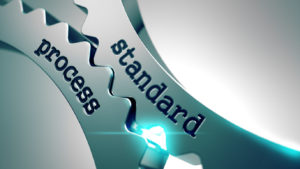The problem: It seems impossible to establish industry-wide standards in complex project development and management. Attempts by even the most powerful interests have failed.
The solution: Expand and intensify efforts at internal, company-driven standardization first.
Ambitious, forward-thinking owner and EPC companies can leapfrog the competition by embarking on a highly focused internal effort to mine historical project data and to leverage the intelligence and passion of new and veteran employees in an organized structured way.
NASA’s efforts to in-house knowledge standardization efforts as described in our interview with NASA’s Chief Knowledge Architect is an example of how large organizations are working on advancing the practice of knowledge management inside the organization.
When the core founding team of Concord® Project Technologies first came together in 2012 to work on its first project consisting of advanced work packaging platform mapping, patterns for standardization across aspects of complex project information and teams started to emerge from the mapping process. Our team then started looking into the definition of a minimal project functional baseline™ for projects involving complex, multidisciplinary and multi-party teams supporting these patterns. This functional baseline is a common self-sufficient functional core from which all projects start.
As we advanced our research and development efforts, it became clear for us that a deep dive into the field of standardization was needed. We consulted veterans of this research field, looked into why standardization efforts fail in our industry and have subsequently developed our own Principles for Standardization Protocol (PSP™) that we have since used consistently in the research, design, and development of Team.Concord®™ (a.k.a T-CON™), the industry’s first Project Performance Acceleration Platform™.
This new approach to company-driven standardization holds that standardization is not about some vague notion of “doing good.” Standardization is about making rational performance gain decisions and these could be checked against Principles for Standardization Protocol (PSP) in the projects world. These principles are:
1 | Standardize with priorities
Are you looking for technical superiority or business superiority? When deciding which standardization efforts to sponsor, companies must give more weight to market factors than to technical factors, to improve adoption of the standards decision. That said, technical superiority needs to fit a business case, otherwise, it becomes a burden.
2 | Standardize with purpose
What is the purpose of your standardization effort? Most companies focus on design and specification standards, but consider, for example, that significant resources are typically spent on the non-engineering information development and exchange. A company should consider what gains might be achieved by standardizing this exchange of information. Recall that complex project professionals who actually create the standards are working in an area of imperfect knowledge, cost constraints, limited incentives, changing relationships, and often, long-range planning with short cycled economic conditions.
3 | Know the cost of inaction
If a method or process is known to produce superior results, the decision not to standardize is a decision to accept losses. For example, a project delivery platform backed by Advanced Work Packaging gives a clear competitive advantage to companies who implement it properly, while moving processes and activities to the cloud has resulted in significant savings and increased efficiencies for early adopters. Leaders should be prepared to explain why they’ve opted for substandard performance when better alternatives are available and have proven results in parallel environments.
4 | Choose the right venue for your standardization efforts
The best way to ensure that your standardization effort will succeed is to carefully choose the right venue. The risk of conflicting interests killing the standardization effort is great, whether you’re standardizing in-house or industry-wide. As standardization expert Carl F. Cargill wrote:
“When you put two dozen people with conflicting emotions, goals, backgrounds, and personal motivation in a room, ask them to decide on a complex interface whose future characteristics may or may not impact the market, their respective companies and their personal careers, and then provide minimal guidance and no enforceable deadline, the outcome is hardly a standard that works for everybody.”
Many promising standardization efforts in the industry — or within companies — have been thwarted because the idea was put to the discussion in the wrong venue. Choose yours carefully.
What other principles have your organization been applying to support the success of your project standardization efforts? Click on the feedback button on top of the page, add a comment or email us here.
How T-CON™ Helps your organization’s Internal Standardization Process
Concord® Project Technologies Inc. has developed and validated the first Platform supporting the standardization of non-engineering information for capital projects. This innovative platform (T-CON™) helps companies bring structure and intelligence to their previously executed projects, as well as their existing and upcoming projects.
This platform enables you to:
Easily mine historic data to facilitate smart, fast searches across your company’s “lessons learned” databases, your project documentation – including PDFs, as well as your company’s emails, communication channels and all file types. Our Live Intelligent Search Assistant (LISA™), supported by big data and artificial intelligence, is a core component of T-CON ensuring that you get the right answers to your questions and helps reduce the time wasted by your teams looking for the right source of information.
Continuously build a structured knowledge library as your team feeds knowledge into T-CON™ in real time. Save on staffing, document management and re-organization at the end of every project and facilitate data decommissioning at the end of the project without the struggle of contractual risks. Our team helps you easily structure your cloud servers to match the project contractual packages without limiting the extent of collaboration between various stakeholders.
Extract ready-to-analyze information about your project and save hundreds of thousands in benchmarking efforts. Additionally, use passive non-intrusive data collection to continuously evaluate your project delivery system components.
Stay in control of your internal information and protect your competitive advantage. Share only what you choose to share with external consultants and auditors and various contractors and keep traceability over their access and interactions. Additionally, you would be able to use remote wipes functionality ensuring that you remain on top of enforcing your contracts and data decommissioning.
Make data the start of the decision-making process, not the end.
The T-CON™ knowledge infrastructure is derived from our belief that bad data is worse than no data at all. All numbers are not facts. As Richard Royall, professor of stats at Johns Hopkins says, when faced with data it’s critical to ask three questions: What does the data imply? What do I believe? What should I do, considering both. Answering these questions is the first step to a successful digital transformation.
Contact us to talk about how we can help your organization access unprecedented sources of data integration and activate your standardization protocols.





